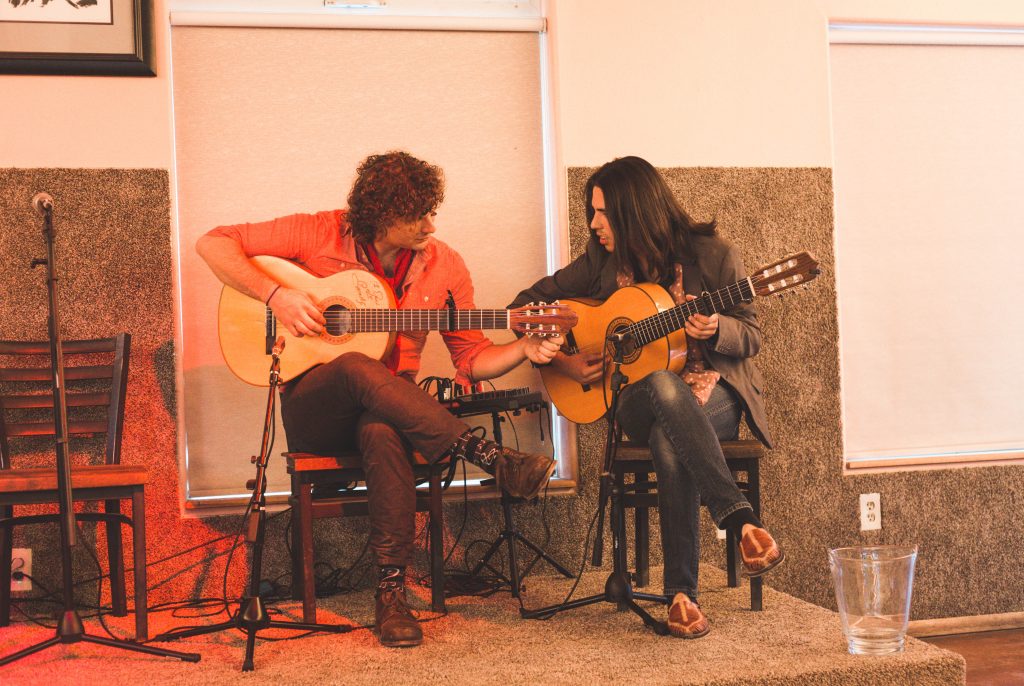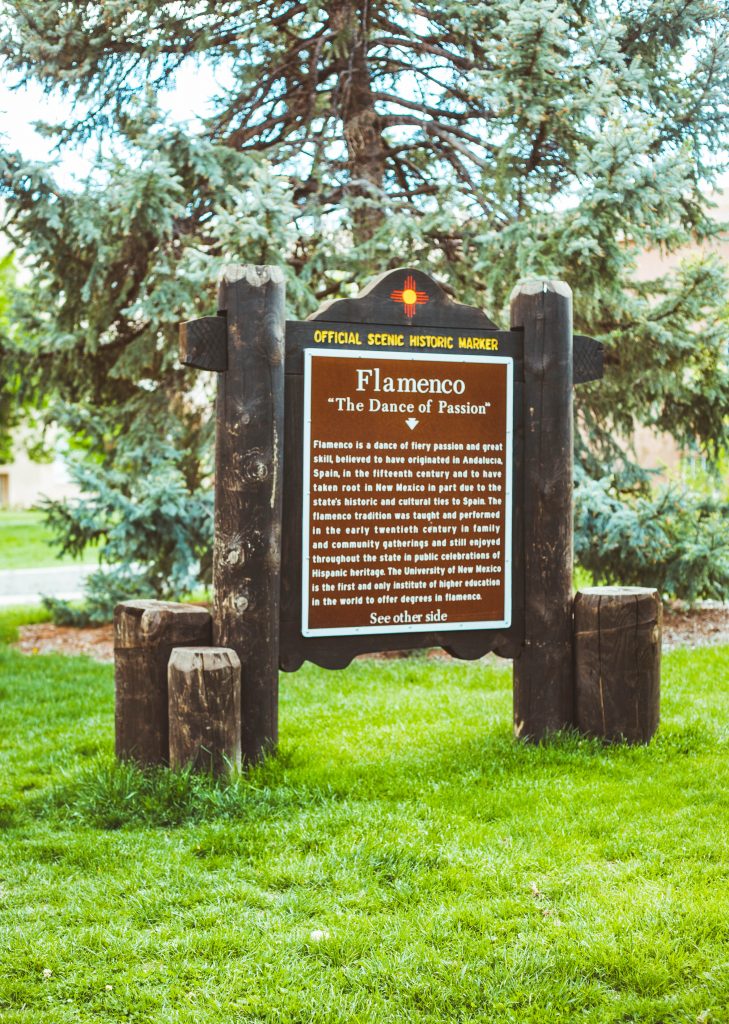Albuquerque is at the heart of a flamenco community.
This is largely due to UNM having the only dance program with a focus on Flamenco dance and history. In recent years, the city has made strides to be more accommodating of this culture. There is now a charter school called Tierra Adentro that feeds into the flamenco program at UNM, which can feed into Yjastros, UNM’s resident dance company.
UNM alumna Sarah Hartshorn said that during her time as a flamenco critical studies graduate student at UNM there wasn’t a performance program for flamenco yet. Hartshorn chose to focus on researching how flamenco was being taught in the United States during her graduate studies. She went on to create the first research symposium within the Festival Flamenco as a way of bringing other people who were researching flamenco to Albuquerque. This became a road map for the historic side of the Flamenco program.
The Festival Flamenco is an annual event that brings dancers from all around the world to perform and hold workshops to educate the local dance students.
“There a lot of people that want to be a part of flamenco and research and learn about it, but maybe they don’t want to be full-time performers,” Hartshorn said. “You have to be able to have the people that can spend the time in the studio and you have to be able to have the people that can teach everybody about what they’re seeing on the stage… that can talk about it in an informed way so that you’re creating a whole environment of people that are educated.”
Hartshorn is currently a teacher at Tierra Adentro: The New Mexico School of Academics, Art and Artesanía (TANM), a school that allows students to study the arts in a rigorous curriculum of academics and performing arts. “Artesania” is spanish for “crafts”. This can include pottery, furniture making, sewing and costuming, and jewelry making. The art incorporates, “cante” meaning song, Spanish/flamenco guitar, cajon and castanets.

According to their website, “The function of TANM is to ensure quality education for our children while facilitating a deep understanding and practical application of New Mexico’s cultural roots and traditions. We will succeed at addressing the critical need for generational continuity of New Mexican culture through academics, Spanish language, art and artesanía.”
The co-director of the school Veronica Torrez said that students begin building their foundation in flamenco from grades six through nine. In 10th grade, they choose a focus in art, artesania, music or dance. From then on, they do their academic work in the mornings and study their chosen focus in the afternoons.
“It’s kind of like we give them this big dance watering hole, and however much they want to drink out of it they are allowed to,” Torrez said.
Starting in their junior year, the students have the opportunity to take dual credit classes at UNM. For flamenco-focused students, they take Intermediate Flamenco their first semester of dual credit.
Eva Encinias-Sandoval is the professor of flamenco at the University, as well as the founding director of the National Institute of Flamenco which often collaborates with UNM and TANM.
“Now what we’re finding is a lot of the kids a lot of the young people that are graduating from TANM are interested in coming to the University to get a degree in either dance or music,” Encinas-Sandoval said. “So that’s really nice because we’re seeing that full 360 idea of our early training in childhood starting to come back to the University. That’s another way I feel that the marriage between the non-profit and the institution of the University is really a win-win situation,” Encinas-Sandoval said.
For 12th-grade TANM student Madison Olguin, being part of the flamenco program at UNM is the goal. She has done enough dual credit through her junior and senior years of high school that when she begins college, she will have almost all of her UNM core requisite classes completed.
“I had to go through the audition process my senior year,” Olguin said on auditioning for the flamenco program at UNM. “Usually you’re not supposed to do it until your sophomore year of college, but they’re like, ‘You’re in a place we think you’re ready to be in the program.’”
Olguin has been attending Tierra Adentro since 6th grade and has excelled through the flamenco-focused curriculum.
“Usually when you go into the flamenco program, you’re kind of in a beginning level and I feel like I’m just going to really be able to use the resources that are available and really grow as a dancer because I’ll just be focusing on dance,” Olguin said.
UNM Modern Dance professor Vladimir Reche spoke about how modern dance technique works with flamenco dance technique and vice versa.

“It is a pleasure for me to work with flamenco dancers. They have wonderful work ethics. Their musicality is exemplar. Their dedication and commitment unparalleled and they have a distinct sense of ground,” Reche said. “I believe that modern dance is very supportive towards the understanding of alignment outside of their main technique and dance form and demands distinct access to the movement and how it connects with the ground and gravity.”
UNM flamenco student Samantha Martinez said that her experience in the UNM dance program has deeply impacted her perspective.
I really think if it weren’t for the dance program, my life wouldn’t be as rich as it is…”
Samantha Martinez, flamenco student.
“Joining flamenco completely flipped my world around because now I’m all about it,” Martinez said. “I really think if it weren’t for the dance program, my life wouldn’t be as rich as it is… I just hope that people start to open their minds to the arts and to dance and to music and to movement and not see it as this leisurely thing, but to see it as a journey that will make you a more respectful person in the world.”
Martinez says that she spends approximately 10 hours a week rehearsing outside of class. She describes flamenco as an art form and lifestyle that demands respect and dedication.
Flamenco surfaced in Spain between the 9th and 14th Century during the Roma migration from India to Spain. Roma in spanish means “gitanos”, gypsies. The gypsies brought with them dance, song, and a variety of instruments including wooden castanets. When having encountered the Sephardic Jews and the Moors, flamenco was then born. The gypsies were considered low class and un-educated, their dance and song became a voice for them, a way of expression.
Flamenco is not all passion and fire– these terms used often when articles are written– but rather it is a symbol of strength and endurance. Through every movement, you can feel the power of generations emanating through the body if the dancer, it can be painful and also show beauty. This is only a part of Flamenco.
“Through the years flamenco has really developed an important place in the University community and in the community at large,” Eva Encinias-Sandoval said.
Anna Padilla and Andrea Solis are reporters for the NM News Port — contact on Twitter @AnnaLPadilla and @drearooo